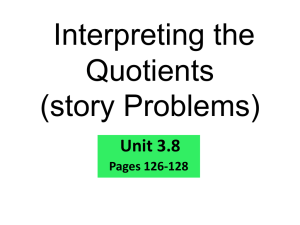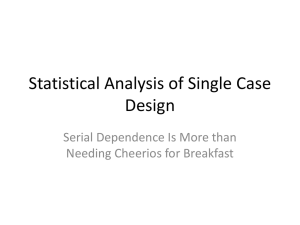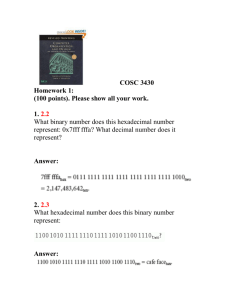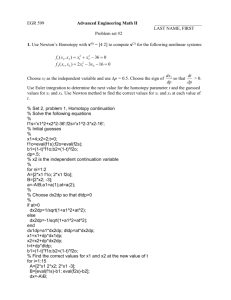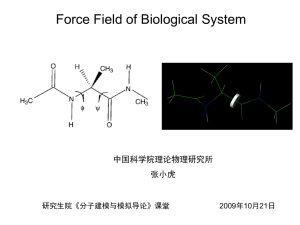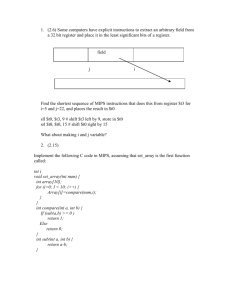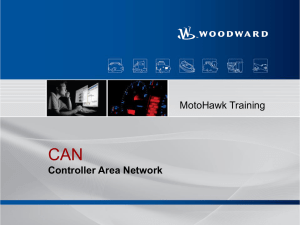Marlene RedDoor
advertisement
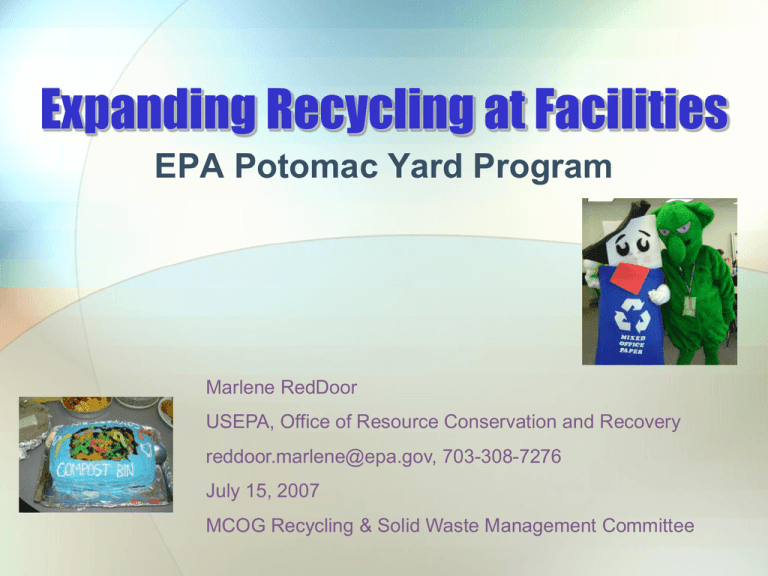
Expanding Recycling at Facilities EPA Potomac Yard Program Marlene RedDoor USEPA, Office of Resource Conservation and Recovery reddoor.marlene@epa.gov, 703-308-7276 July 15, 2007 MCOG Recycling & Solid Waste Management Committee A Comprehensive Approach • • • • • • • Building Relationships Building General Awareness Tools and Events to Educate Volunteer Green Teams Doing Research Creating Proposals and Options Keeping it going - Short and long term goals • Budget? How we Approach it – Environmental Stewardship • Stewardship is taking personal responsibility and interest in management of something entrusted to one's care. • Environmental stewardship is the responsibility for environmental quality shared by all those whose actions affect the environment. Build Relationships with Everyone Needed for Success • We have volunteers from all working offices in PY (ORD, OPP, OSWER) • Also our facilities and building managers – Edgar Lewis (OARM/FMSD) and Maureen Dowling (Jones, Lang, LaSalle) • EPA’s Recycling/EMS Coordinator – Dexter Johnson (OARMFMSD) • Also the part time volunteers willing to work on key projects • Reps from our Emerging Leadership Network • Managers also sign off on the Charter & Projects Why? • Environmental Statutes • RCRA, Pollution Prevention Act, Clean Air Act, etc. • Executive Orders 13423, 13514 • Environmental Management System implementation • Local Ordinances Walking the walk! Talking the talk! Potomac Yard Green Team MISSION: •Take the lead in advising on, supporting, and implementing practices to reduce EPA’s environmental footprint at Potomac Yard (PY), • promote these practices among its tenants, and • serve as a model for other facilities, offices, or groups at EPA and in general. CHARTER: •Signed by all PY ODs and/or DODs Recycling Goals • • • • • • • • • • • Implement a compostable waste collection Refine measurement capacity and set baselines statistics Record quarterly numbers for recycling commodities (paper, containers, etc.) (continue) Recycle toner cartridges for all printers and copiers (continue) Collect and recycle fluorescent bulbs (where not done) -count number Recycle electronics equipment and participate in the Federal Electronics Challenge Increase the recycling of cans, bottles and plastics, paper, and newspapers (out of waste baskets) Participate and help promote a “clean your files day” event at least once a year Recycle binders, file folders and binder clips – set up recycling stations for office supplies Institute “Techno Trash” Collection for all of Potomac Yards (http://www.greendisk.com/gdsite/services.aspx ) Set up Plastic bag recycling Events for America Recycles Day Measurement Warm Model: Waste Reduction Calculator http://epa.gov/climatechange/wycd/waste/calculators/Warm_home.html - You can take your information and use this calculator Potomac Yard Recycling Amounts in Tons and Diversion Percentage for 2007 2009 Two Potomac Yard Jan Feb March April May June July Aug Sept Oct Nov Dec Total Mixed Office Paper 1.7600 2.2800 1.2600 1.2190 1.0100 0.5000 1.4982 1.2441 1.1951 1.3875 1.4060 14.7599 Newspaper 0.0760 0.1000 0.0640 0.0260 0.0280 0.0320 0.1115 0.0405 0.0770 0.1435 0.0660 0.7645 Plastic/Glass/Alumin um 0.1070 0.0800 0.1800 0.1300 0.1300 0.2100 0.1910 0.2040 0.2435 0.3195 0.2985 2.0935 Plastic Bags 0.0000 0.0000 0.0000 0.0000 0.0000 0.0070 0.0000 0.0000 0.0000 0.0000 0.0245 0.0315 Light Bulbs 0.0010 0.4800 0.0017 0.0060 0.0007 0.0013 0.0004 0.0115 0.0008 0.0001 0.0016 0.5051 Ink Toners 0.0500 0.0780 0.0900 0.0760 0.0470 0.0660 0.0360 0.0270 0.0305 0.0050 0.0195 0.5250 Batteries 0.0220 0.0230 0.0210 0.0210 0.0130 0.0260 0.0165 0.0210 0.0210 0.0145 0.0185 0.2175 Shredded Paper 0.0000 0.0000 0.0000 0.0000 0.0000 0.0000 0.0000 0.0000 0.0000 0.0000 0.0000 0.0000 Cardboard 0.2100 0.3400 0.3200 0.3104 0.2800 0.2700 0.4818 0.2541 0.1702 0.5439 0.3996 3.5800 Total for Recyclables 2.2260 3.3810 1.9367 1.7884 1.5087 1.1123 2.3354 1.8022 1.7381 2.4140 2.2342 Refuse 2.2600 2.4000 1.7700 3.1490 2.4400 1.8900 3.0756 2.4189 2.8749 3.7000 2.0868 Total 4.4860 5.7810 3.7067 4.9374 3.9487 3.0023 5.4110 4.2211 4.6130 6.1140 4.3210 Total Diversion 49.62 % 58.48 % 52.25 % 36.22 % 38.21 % 37.05 % 43.16 % 42.70 % 37.68 % 39.48 % 51.71 % 28.0652 #DIV/0 ! #DIV/0! Local Community Involvement For Our Environment and Our Community How do we get everyone onboard? • • • • • Do the research for “them” Make it easy Save “them” money Provide Volunteers Give away food Compostable Waste Pilot • • • • • • Looked at programs already in progress Wrote Proposal Found 2 haulers Used bins already in warehouse Sent out all hands notice for each floor Held pizza luncheon with presentations from Haulers and Green Team • Had bins in room and used them during demonstration • Made visual display boards for each floor • Tried out different signs Pilot Program Proposal What we are testing? • PY can increase its waste diversion rate to 80% with compostable waste collection separated from trash – time frame of 2 years. (Pilot tests amount changed on 5 floors) • It can also cut down on the number of plastic bags place in the waste stream by “kicking the can” out of individual cubicles and into a more central location. • What’s left in the trash after compostable collection? What will we collect and in what containers? •Compostable waste consists of items that can be composted in a commercial composting facility •All food - including meat, bones and eggshells. •Plants – trimmings, leaves, grass, brush, weeds, etc. •Other compostables – waxed cardboard, pizza boxes, paper products (napkins, paper towels, plates, cups, milk cartons, etc), tea bags, coffee grinds and filters, biodegradable (biobased) utensils, cups and containers. (plastics containers made of soy or corn based materials like clamshell containers – on if it has a label saying polylactic or the equivalent). •Any compostable container that has been contaminated from the recycling stream by having food waste on it. Information in Proposal • • • • • • • • • • • What will change? Where to collect it? (Locations) In what is it collected? Who collects the compostable waste? Where does it go? (from floors to lower level in bldg.) When is it collected? (How often?) What floors will be in the pilot (5 out of 12 floors in pilot) What else has to be changed? Implementation: Process and Sequence – when and how Timeline Contractors Info • Building owner had all information to give to bidders when current contract was ended • Gave 2 sources • Envirelation – Walker Lunn - 202-465-4802 http://www.envirelation.com/contact.html • Bates Trucking – Tara Lewis - 301-699-3268 http://www.batestrucking.com/ • 3rd Source Found • Paterson Environmental Holdings, Harold B. Wiggins, 410-588-9729 (Hauls out of DE and has transfer station in MD) http://www.marylandrecyclingnetwork.org/webi nars/Composting-MRN.pdf Success… • 5 Floors in building piloted • All tenants by December 2010 • Diversion looks to be about 80% of what was in the trash in kitchens • All paper towels from restrooms • Smaller amounts of compostable waste in trash each week • Numbers out in a few weeks – May – July. Tools and Sites • EPA Compost Web Site • http://www.epa.gov/epawaste/conserve/rrr/composti ng/science.htm • http://www.epa.gov/epawaste/conserve/rrr/composti ng/pubs/index.htm • Nearest Facilities • http://www.recycledgreenindustries.com/index.html • http://www.peninsulacompostcompany.com/facilities /WORC.html • Environmental Stewardship Resource Guide: • http://www.fedcenter.gov/epa/oswer/esrg/index.htm



